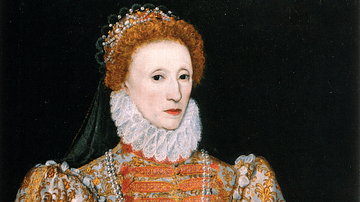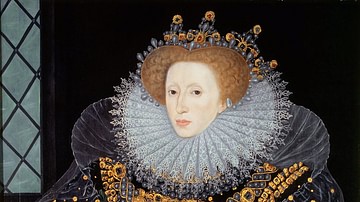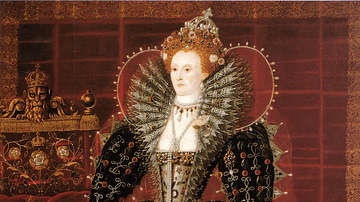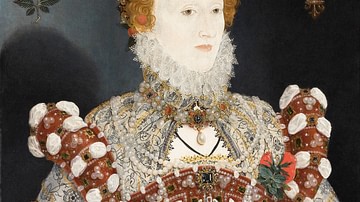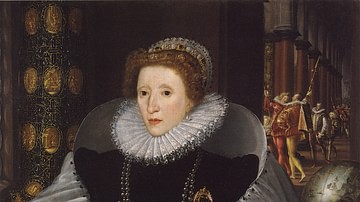Illustration
A c. 1592 CE portrait of Elizabeth I of England (r. 1588-1603 CE) known as the 'Ditchley Portrait' after the courtier Sir Henry Lee who commissioned it and who had estates at Ditchley near Oxford. It was painted by Marcus Gheeraerts the Younger (c. 1562-1636)
The queen's white dress and pearls symbolize purity and link her to the Virgin Mary while she stands on a map, indicating her imperial power on earth. The queen's divine power is symbolized by the armillary sphere earring she wears.
There is an unusual amount of text in this painting, all of which, along with the visual imagery of storm clouds clearing, present a theme of forgiveness. There are three mottoes (left, right and bottom) in Latin which mean:
She gives and does not expect
She can but does not take revenge
In giving back she increases
The block of text on the right is a sonnet and reads:
The prince of light, the Sonne by whom thin(gs)
Of heaven the glorie, and of earthe the (grace?)
Hath no such glorie as (...) grace to go (...)
Where Correspondencie May have no plac(e)
Thunder the Image of that power dev(ine)
Which all to nothinge with a word c(...)
Is to the earthe when it doth ayre r(...)
Of power the Scepter, not of wr(...)
This ile of such both grace (...) power
The boundless ocean (...) em(...)
P(...) p(rince?) (...) the (...)ll (...)
Rivers of thankes retourne for Springes (...)
Rivers of thankes still to that oc(ean) (...)
Where grace is grace above, po(wer)
National Portrait Gallery, London.
Cite This Work
APA Style
Younger, M. G. t. (2021, November 23). Elizabeth I Ditchley Portrait. World History Encyclopedia. Retrieved from https://www.worldhistory.org/image/14896/elizabeth-i-ditchley-portrait/
Chicago Style
Younger, Marcu Gheeraerts the. "Elizabeth I Ditchley Portrait." World History Encyclopedia. Last modified November 23, 2021. https://www.worldhistory.org/image/14896/elizabeth-i-ditchley-portrait/.
MLA Style
Younger, Marcu Gheeraerts the. "Elizabeth I Ditchley Portrait." World History Encyclopedia. World History Encyclopedia, 23 Nov 2021, https://www.worldhistory.org/image/14896/elizabeth-i-ditchley-portrait/. Web. 18 Apr 2025.


